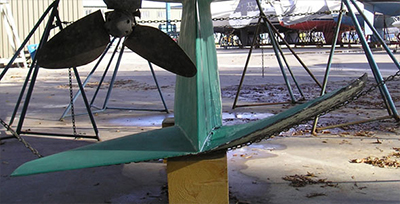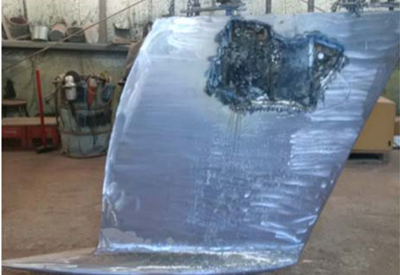Keel Damage & Repair Part 1

Mar 7, 2017
The types of keel damage that I see here at MarsKeel Technology are grounding damage, frost damage and corrosion of keel bolts with grounding damage being the most common. Grounding damage on fin keels is generally in the form of deformation from impact, bending damage, twisting damage or cracking. Most of the time there are multiple forms of damage on a single keel which can be attributed to the design of the keels with high aspect ratio keels being most susceptible to the entire range of damage types.
Conditions that effect the damage are the boat speed at impact, bottom conditions (rock, sand, etc.), the angle of impact (head on, glancing blow, etc.) plus the sectional area of keel. The challenge is if the keel didn’t “absorb” the impact energy, where did it go and what did it do when it got there?
It can all be started by a “simple” impact on the forefoot of the keel just, off centre line which can result in the fin being bent, twisted, warped, and cracked. This makes the assessment of the damage more complicated, trying to see if all those things are present or not, and proving it before a repair is started.
If it is not obvious you can spend a long time trying to definitively say that the keel is NOT damaged as the keel may look bent on the boat, but is it for example hanging perpendicular off the fair body? Is the keel on centre line? We use a combination of modern technology (eg. Lasers) plus old technology (eg. plumb bobs and straight edges and tape measures) to try to measure the damage which helps to remove what you think you see from what you are looking at.
 Everyone has a perception of what they expect to see and this can get in the way of seeing what is there which is why we take our time setting up tools to define the damage and have several people from different areas look at it. It is common for us to have our plant manager (27 years’ experience), our lead fairing person (15 years’ experience) and myself look at the keel.
Everyone has a perception of what they expect to see and this can get in the way of seeing what is there which is why we take our time setting up tools to define the damage and have several people from different areas look at it. It is common for us to have our plant manager (27 years’ experience), our lead fairing person (15 years’ experience) and myself look at the keel.
We all see the keel from different professional points of view and it is when these multiple observations are discussed and compared that we can best define the damage.
Once the damage has been assessed on the boat there is the immediate question of is it worth removing the keel to have it repaired? As you know removing a keel can be simple, if the hull keel joint is open and compromised, the keel almost falls off, or it can involve hours of slow, careful work and effort. During this time, there is always the risk of damage to the hull, keel bolts or the keel.
Now that the damage has been defined the next questions are,
1. Can it be repaired?
2. Should it be re-cast?
3. What is the cost?
4. How long will it take?
In the terms of more compound damage the questions and concerns over cost/ price and time get larger. Once the decision is made to consider a repair we need to know if the job can be physically done, and the price. It may be that the damage is sufficient to require a re-cast of the keel which may result in the least expensive, fastest, simplest and most successful outcome. The price for the effort needed to repair a keel may in fact be more than the cost of making a new keel. This process of course is only practical when the tooling is available or can be created.
On other occasions, it is not possible to recast and a repair is the only reasonable option.
The point is, life is never simple in the marine world. Just because we can repair something is it worth repairing?
By: William Souter, Chief Technologist
MarsKeel Technology® www.marskeel.com




























